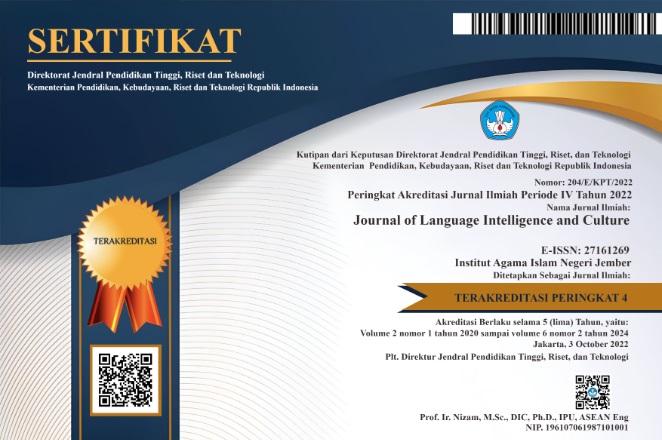The Application of Cambridge Curriculum in English as Second Language Teaching Learning at Secondary School
DOI:
https://doi.org/10.35719/jlic.v5i1.115Keywords:
Cambridge curriculum, English language teachingAbstract
Pelita Hati Secondary School Jember implements Cambridge Curriculum as a holistic international curriculum which integrated learners from the primary until the high level. This school has been considered to be the only school that has a Cambridge curriculum’s licence in Jember. The research focus of this study are 1) Why does Pelita Hati Secondary School implement Cambridge curriculum?, 2) What is the concept of Cambridge curriculum applied at Pelita Hati?, 3) How is the implementation of Cambridge curriculum on English (as second language) teaching learning?. This study used qualitative approach with case study design. Data collecting techniques used in this study were observation, interview, and document review. To analyze the data, researcher use data condensations, data display, drawing and verifying conclusions from Miles and Huberman (2014). For data trustworthiness, researcher use source triangulation, technique triangulation. The findings showed that: 1) The Pelita Hati School implement Cambridge curriculum affected from the ANPS meeting conference in 2011. Because, in the prior time the school with a bilingual system since 2006 doesn’t has a certain curriculum to support their bilingual system. 2) The concepts of Cambridge curriculum in Pelita Hati in term of the components consist of the objective, the content, the process, and the evaluation components 3) Cambridge curriculum implementation in English subject include the planning, the content which consist of learning activity (preliminary, core activity and closing activity), global material, discussion method, projector and audio media and Evaluation include the placement test, classroom assessment, achievement test and diagnostic test.
References
Ary, D., Lucy C. J., Chris S., & Asghar R. (2014). Introduction to Research in Education, 9th Edition. Belmont USA: Wadsworth.
“Cambridge Assessment International Education Official Website.” Cambridge University Press & Assessment. 2022. 22nd March, 2022. https://www.cambridgeinternational.org/.
“Cambridge Lower Secondary brochure.” Cambridge University Press & Assessment,2021.https://www.cambridgeinternational.org/images/607719-cambridge-lower-secondary-brocure.pdf.
“EF EPI 2022 - EF English Proficiency Index”, Signum International AG 2022, Accessed 1st November 2022. https://www.ef.com/wwen/epi/.
Huzairin, S. (2017). Sikap Bahasa Siswa SMP dan SMA Terhadap Pembelajaran Bahasa Inggris di KotaBandar Lampung. AKSARA : Jurnal Bahasa dan Sastra 18, no 1: 44-45.
“International Curriculum.” Cambridge University Press & Assesment 2022. Accessed20thMarch,2022. (https://www.cambridgeinternational.org/why-choose-us/benefits-of-a-cambridge-education/international-curriculum/ .
“International Education Programmes and Qualification.” Cambridge University Press & Assessment 2022. 20th March, 2022. https://www.cambridgeinternational.org/programmes-and-qualifications/.
Kielmann K., Febiana C., & Janet S. (2012). Introduction to Qualitative Research Methodology: A Training Manual. United Kingdom :Department for International Development (DFID).
Miles, M. B., Hubberman M., & Saldana J. (2014) Qualitative Data Analisys : A Methods Sourcebook. 3rd Edition. California, Sage Publication Inc.
Patton, M. Q. (2015) Qualitative Research & Evaluation Methods. United Kingdom: SAGE Publications.
Pelita Hati School, Pelita Hati School Profile, 10th November, 2016,video, 1:25, https://youtu.be/D7zRi_VZcjE.
Pelita Hati School. Pelita Hati School – Success & Excellent, accessed March 15, 2022. pelitahati.sch.id.
“The Cambridge Approach to assessment,” UCLES, 2018, Hal 3. https://www.cambridgeassessment.org.uk/Images/cambridge-approach-to-assessment.pdf.
Poedjiastutie, D., Fida A., Deviy H., & Gasmi F.N. (2018). Does Curriculum Help Students to Develop Their English Competence? A Case in Indonesia. Arab World English Journal (AWEJ) 9, no2:175-185.
Downloads
Published
How to Cite
Issue
Section
License
Copyright (c) 2023 Dewi Nurul Qomariyah, Nur Khasanah

This work is licensed under a Creative Commons Attribution-ShareAlike 4.0 International License.













